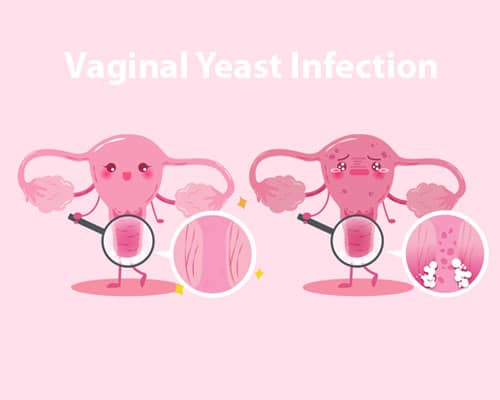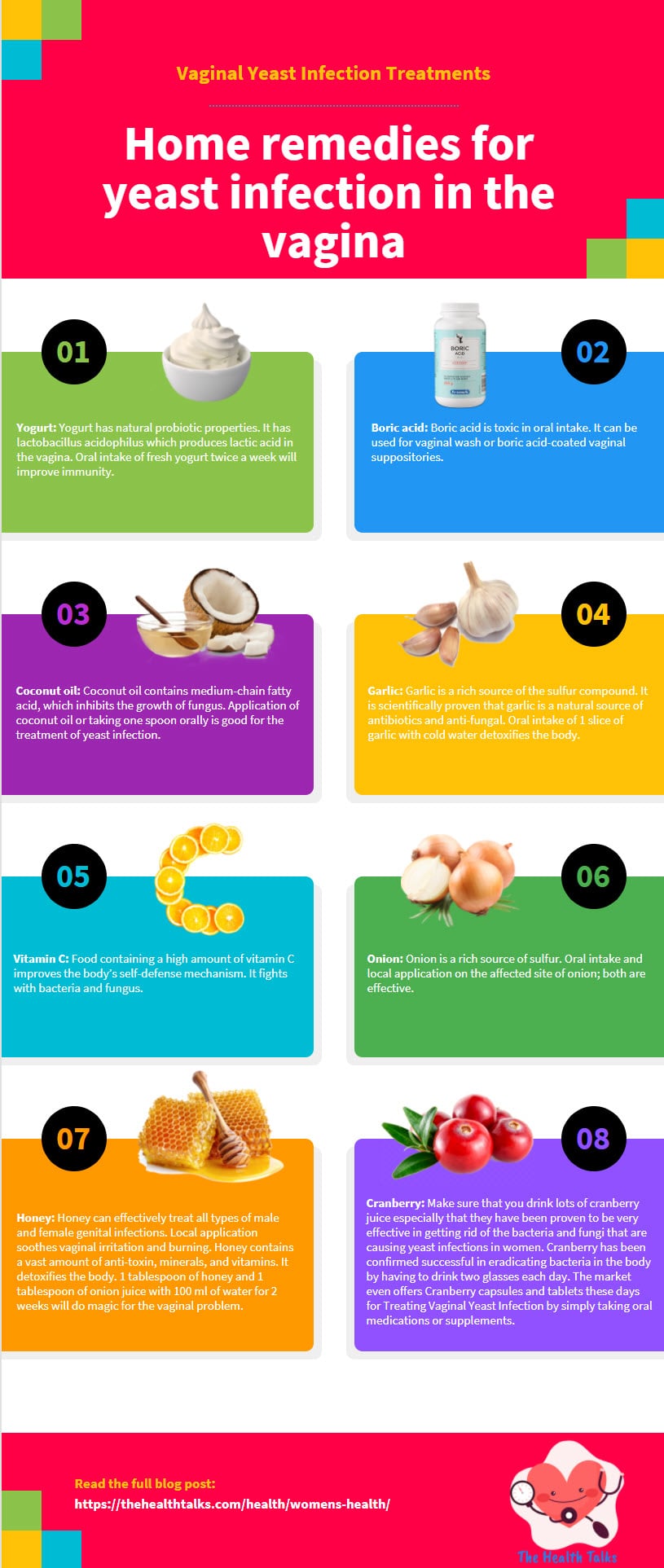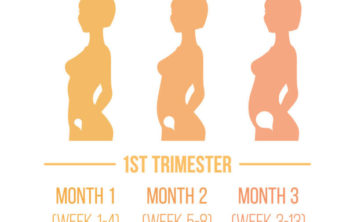Contents
Vaginal Yeast Infection: Causes, Symptoms, Treatment and Home Remedies
Do you know there is yeast naturally found in the vagina that does not cause any problem, but there is a time when it can be problematic? This occurrence has been named vaginal yeast infection. It is also called vaginal thrush and vaginal candidiasis.
What is the vaginal yeast infection?
Human Vagina provides accommodation for numerous amounts of bacteria, fungus, and other pathogens. Some of these pathogens are good, and others are bad for the body. Good bacteria kill bad bacteria and maintain the normal growth of fungus. If by any means, this equilibrium gets imbalanced, it leads towards the overgrowth of bad bacteria and yeast. This overgrowth of yeast is called a vaginal yeast infection.
So, in short, the uncontrolled growth of yeast in the vagina, which results in itching and pain, is known as a vaginal yeast infection.
1. What causes a vaginal yeast infection?
Vaginal yeast infection is the result of Candida Yeast. Scientists have found more than 200 types of candida strains, out of which 15 types of candida cause infection in the vagina. The most common type of candida infection is because of Candida Albicans.
Vaginal yeast infection causes:
1.1. Antibiotics:
Antibiotics kill bacteria irrespective of their good or bad nature for the body. The killing of good bacteria provides a conducive cellular state of the body to get infected with a number of pathogens. Yeast infection of the vagina is one of them.
1.2. Immunosuppressive conditions:
Low immunity means the inability of the body to fight against pathogens. A low level of immunity can cause yeast infection of the vagina.
1.3. Diabetes:
Chances of vaginal infection are directly proportionate to diabetes. Increased level of blood sugar increases the chance of vaginal yeast infection.
1.4. Douche:
Douche is a vaginal instrument that is used for vaginal wash or sexual pleasure. Using douche can interfere with the equilibrium of the vagina, which leads to infection.
1.5. Steroid:
Long-term use of steroids is prohibited in medical science because it can decrease the body’s immunity which can lead to vaginal yeast infection.
1.6. Hormonal imbalance:
Hormonal imbalance plays an important role in yeast infection. For the idiopathic reason, it has been found in the observation that yeast infection is common in puberty and menopause.
1.7. Poor hygiene:
Not maintaining proper hygiene during daily life and during periods may lead to yeast infection in the vagina.
1.8. Unsafe sex:
Unsafe sex can lead to various types of infection. It may transit yeast infection as well as sexually transmitted disease.
1.9. Wet cloths:
Wearing wet clothes for a long period of time may increase the chances of yeast infection.
1.10. Moist environment:
The moist environment is the most favorable for the growth of fungus. That’s why yeast infection usually occurs in rainy seasons.
1.11. Diet rich in sugar:
Consuming a diet rich in simple carbohydrates and sugar increases the chances of vaginal yeast infection.
1.12. Stress:
How does stress affects the body is still unclear. But it is very well understood that stress decreases the body’s immunity to a very low level.
1.13. Pregnancy:
During pregnancy vaginal gland produces excessive vaginal discharge and decreases vaginal pH, which causes a favorable environment for yeast growth.
1.14. Wearing tight/non-cotton undergarments:
Tight-fitting underwear can cause friction. And when there is friction, irritation will come right after. It can also increase moisture and temperature in the pelvic area – the perfect environment for the yeast to spread.
1.15. Scratches/scrapes in the vagina:
Irritations like these can put a woman especially at risk of contracting vaginal yeast infection. This can happen during an insertion of foreign objects like tampon or sex toys. On the other hand, scratches in the vagina can also be caused of forceful penetration during sex. It could also be possible that vaginal inflammations are caused by allergies to products like fabric softeners, feminine wash, bath soaps and spermicides.
The use of perfumed feminine hygiene sprays and douches. These products often contain chemicals that disrupt the normal PH balance in the vagina, making it itchier and drier in every application. This kind of effect favors the growth of microorganisms like yeast. If, when applying the product, you feel a burning sensation in the vulvar area, it’s best to stop using them permanently.
1.16. Birth control pills:
While most birth control pills are quite successful in preventing unplanned pregnancies, they have certain side effects that could actually aid in the proliferation of the fungi. As most birth control pills contain estrogen, they can cause sudden changes in the vaginal environment, especially when there are increased hormonal levels in your body. This kind of change is what fungi need to grow and wreak havoc.
Read more: Menstruation or Menses: Cycle, Phases, Signs and Problems
2. Vaginal yeast infection symptoms:
- Vaginal discharge: Vaginal yeast infection discharge is a thick whitish discharge or cottage cheese discharge from the vagina. Sometimes watery discharge may be present.
- Intense itching.
- Pain during sex or after sex and Pain during urination is also common. The severity of pain depends on the duration of the infection.
- Redness of vagina
- Redness of groin region
- Soreness
- Inflammation of vagina and vulva
- Rashes
- Irritation, burning, or discomfort in the vagina
2.1. Pregnancy yeast infection:
Vaginal yeast infection during pregnancy is common due to increased estrogen levels in the blood. Increased level of estrogen causes increased blood flow to the vaginal canal, which in result causes the imbalance of good and bad bacteria. The change in the equilibrium of vaginal canal results in infection of vagina, such as bacterial vaginosis, yeast infection, normal vaginal discharge.
Vaginal yeast infection in pregnancy is 20% more common than bacterial vaginosis.
2.2. Yeast infection in men:
Yeast infection in men’s genital is not as common as compared to women. In men, it is usually limited to the head and skin of the penis. It also does not cause severe symptoms like women. General symptoms of yeast infection in the male are cotton cheese-like discharge underneath in fold of penis or prepuce, Pain and irritation around the penis, and intense itching. Occasionally there may be inflammation of the penis.
3. Diagnosis of yeast infection in the vagina:
- Clinical examination: Self-diagnosis of yeast infection is easy because of its specific characteristic discharge, but it is still a good option to take a piece of advice from the gynecologist.
- Pelvic exam: A gynecologist will exam the pelvis for any abnormality. A finger checkup of the vagina and instrumental visualization of the vagina is a must.
- Vaginal swab: Microscopic examination of vaginal swab will determine about the type of infection.
- Ultrasound: For any other abnormality such as the uterine polyp, cancer endometriosis etc.
Vaginal yeast infection Complications:
Yeast infection is a treatable disease and generally does not cause complications. But an untreated chronic yeast infection can produce major complications.
a. Bacterial vaginosis:
Yeast infection can also occur with bacterial vaginosis and worsen the condition of the vagina. Vagina infected with yeast and bacteria simultaneously are more difficult to treat, and they also produce a combination of symptoms which makes it more difficult to diagnose.
b. Multi-strain yeast:
Commonly yeast infection is because of candida Albicans. Chronic yeast infection can be caused by different other types of candida also.
c. Blood yeast infection or fungemia:
Sometimes fungus can enter into the bloodstream and produces symptoms like fever with shivering, hypotension, confusion, shock, etc. This is a serious medical emergency and needs urgent medical attention.
d. Systemic infection:
The fungus can enter different organs through the blood, which produces more severe symptoms. Symptoms of a systemic yeast infection depend on the infected organ or system. It is again a medical emergency. Yeast infection can also occur in the central nervous system (brain), which can cause irreversible complications in the brain.
e. Infertility:
Chronic yeast infection can produce a tubal block which is an important cause of infertility.
f. Pregnancy complications:
Yeast infection during pregnancy is common and usually does not cause any complications, but chronic yeast infection can involve the cervix too, which can make pregnancy more difficult. During labor, Yeast infection can be transferred to the child also.
4. Vaginal yeast infection treatments:
Yeast infection is easy to treat and responds well with antifungal treatment. Duration of treatment depends upon the immunity and severity of the infection. Patients usually get relief within 3-4 days, but treatment may continue for weeks. The doctor may prescribe oral, vaginal, or intravenous antifungal medicines.
Common antifungal medicines are Fluconazole, Teraconazole, Monisat etc.
4.1. Herbal treatment for yeast infection in the vagina:
- Decoction of Turmeric (Curcuma longa): Wash vagina with this decoction thrice a day.
- Decoction of dry ginger (Zingiber Officinale): Oral intake of 15 ml decoction for three weeks improves immunity up to a marked level.
- Decoction of the bark of nimb (Azadirachta indica): One can apply it as a vaginal wash and taken it orally; both are effective.
- Powder of nimb or extract of nimb (Azadirachta indica): Topical application and oral intake both are effective.
4.2. Home remedies for yeast infection in the vagina:
5. Yeast Infection Preventions
Yeast oneIf you have cured your yeast infection naturally, there is probably a good chance that you do not want to experience a yeast infection again.
If you have cured your yeast infection naturally, there is a good chance that it will not return, but there are things that you can do to ensure that your yeast infection will not return.
- Wipe front to back after using the toilet.
- Avoid anything scented such as soaps, powder or perfumes.
- Do not douche.
- Do not share cloths or towels.
- Use lubrication during sex if required.
- Try to avoid tight clothing.
- Use a condom during sex.
- Take pro-biotics to help boost your immunity
- Wear cotton undergarments.
- There are many many things that can ensure that your yeast infection will never come back.
6. Handling Chronic Vaginal Yeast Infection Properly:
A lot of ladies fear the term Chronic Vaginal Yeast Infection for a number of reasons. One of the main reasons is that the word Chronic is in it. They think that this term refers to an irreversible condition that can lead to death. This is why they often deny that they have the condition to others and to themselves. However, can this help lessen the extent of the condition or can it make the condition worse?
The answer: Definitely, worse
By ignoring the presence of Chronic Vaginal Yeast Infection, you are only making things worse. This is because you will end up refusing medical treatments since you do not recognize its presence. You will think that you don’t need any type of treatment may it be a home or hospital remedy. This can make the situation worse for you.
What Can Further Aggravate the Situation?
Aside from completely ignoring the fact that you are suffering from the condition, the other thing that won’t be able to help you out is panic. You should keep your cool and start focusing on the things that you can do. This will help you get rid of the problem at a much quicker pace. Don’t be fooled into thinking that you have to live with this condition for the rest of your life just because it is labeled as “chronic”
a. The First Step towards Recovery: Healthier Hygienic Routines
Start developing more hygienic routines. Assess yourself if you are brushing your teeth adequately or if your genital hygiene is up to par with the standards. If you have poor hygiene, then the medications and the treatments that you need to undergo will become futile. The amount of antifungal creams that you are going to apply on your lesions would not matter one bit. In order to become aware of the right hygienic regimens, you can talk to your doctor or your health care provider.
b. The Second Step: Knowing the Cause
Chronic Vaginal Yeast Infection can be caused by a lot of factors. By eliminating the cause, you are already eliminating the chances of recurrence and the further progression of the disease. The condition can be caused by stress, low immune system or even pregnancy. If the root cause is pregnancy, then the only thing that you can do is to amp up your hygienic practices.
If it is caused by stress or depressed immune system on the other hand, you can start working on relaxation techniques and other regimens that can boost your immune system. As you can see, the point of your treatment depends on the cause. This is why it is very important to identify the main cause of your problem.
c. The Third Step: Learn to Use the Right Types of Medications
Some people think that Chronic Vaginal Yeast Infection is caused by a bacterial infection. This is why they take antibiotics in the hopes of nipping the problem right at the butt. What they don’t realize is that this condition is caused by a FUNGAL infection. This means that in order to get rid of it, you need to use antifungal medications. Antibiotics or antiviral medications won’t really do much to help with your condition. You will just waste your money and your time since you need to wait for the results before you can move on to other forms of treatment.
d. The Fourth Step: Recognize Your Options
When it comes to the treatment for Chronic Vaginal Yeast Infection, you can either choose a home treatment or a hospital-based treatment. Hospital-based treatment means following the orders of your doctor religiously. This can be more expensive since you will need to go to your doctor’s clinic multiple times.
Home treatments are for those who want to save a lot of money and get rid of the disease quickly. A Step by Step Cure for Yeast Infections is a sure fire regimen that can help cure your condition quickly and efficiently. The best part about this program is that it can assure you that your condition won’t come back anytime soon. It can also guarantee that you won’t suffer from any harmful side effects which happen to be the main problem when it comes to a hospital-based treatment.
7. Some frequently asked questions about yeast infection:
6. Disclaimer:
The above article is only for knowledge purposes. Please contact your healthcare provider before using any of the above medicine or method. for any query or personal consultation according to your health condition, please contact your doctor. Last but not least, finding the best ways of Treating Vaginal Yeast Infection is not that difficult after all. All you will need to do is follow these simple tips and you will surely say goodbye to your vaginal yeast infection in no time! What is more, with the knowledge you have gained about the causes, symptoms and treatments for vaginal yeast infection, you will without doubt not experience any recurrence at all!






Just want to say your article is as surprising. The clearness on your publish is just great and i could think you’re
knowledgeable on this subject. Well along with your permission let me to grasp your feed to keep updated with coming near near post.
Thank you one million and please keep up the enjoyable work.
Hi I am so delighted I found your blog, I really found you by accident, while
I was searching on Google for something else, Anyhow I am here now
and would just like to say many thanks for a fantastic post and
a all round entertaining blog (I also love the theme/design), I don’t have time to go through it all at the moment but I have
bookmarked it and also added your RSS feeds, so
when I have time I will be back to read a lot more, Please do keep up the fantastic
jo.